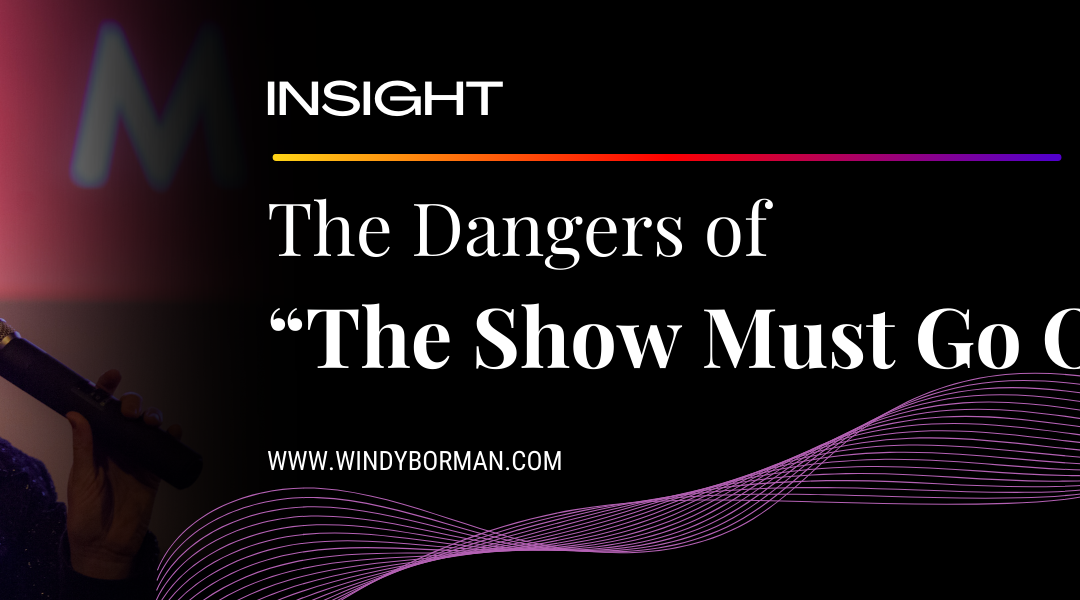Key Take-Aways:
- The saying “The Show Must Go” prioritizes capitalism over safety. Instead I propose we Move at the Speed of Safety.
- Live performers for television, theater, music, dance, etc. are put into dangerous situations if they cannot stop the performance due to safety concerns.
- Stage Combat and Intimacy Coordinators have safety techniques (such as hand signals) that allow performers to communicate, give consent, and express safety concerns non-verbally.
- We can keep performers, crew, and audiences safe by having a code of conduct, a safety plan, hand signals, and a list of people who can stop the show if concerns arise.
Content Warnings: Domestic Violence, Stage Violence, Sexual Assault.
There have been countless opinions about the 2022 Oscars incident involving Will Smith and Chris Rock. I am not offering another opinion on the behavior. Instead, I offer an opinion on safety.
In particular, I want to discuss the dangers of “The Show Must Go On” mindset and offer an alternative that prioritizes safety over commerce.
Origins of “The Show Must Go On” Saying
According to Wikipedia:
“The show must go on” is a phrase in show business, meaning that regardless of what happens, whatever show has been planned still has to be staged for the waiting patrons…
The saying and principle are traditional in the theater, but they both originated in the 19th century with circuses. If an animal got loose or a performer was injured, the ringmaster and the band tried to keep things going so that the crowd would not panic[1] because “it is a point of honour not to let the other players down by deserting them when no understudy is available”.[2]
Let me write that again for emphasis. Even if “a performer was injured” the motto was “keep things going”. This prioritizes capitalism over safety.
Since the heyday of circuses in the 19th and early 20th centuries, we’ve seen the abolition of slavery and the movements for labor unions, women’s suffrage, civil rights, Black Lives Matter, and #MeToo.
Why then are performers and producers still defaulting to this old mindset that we must deliver the planned show for patrons regardless of safety concerns?
A Dangerous Mindset
Violence and injuries on stage are, unfortunately, not new. Twenty years ago when I was an undergraduate studying theater, I heard about actors changing the stage combat choreography, which resulted in physical and emotional trauma. In one such example, during a performance an actor changed a stage slap (a slap that looks real to the audience, but does not make contact with the other actor) to a contact slap (a slap that does make physical contact with the actor). The contact slap broke his co-star’s nose. Due to the shared mindset that “the show must go on”, she continued with the next scene and sang a ballad with a bloody nose. She was commended for “staying in the moment”; he faced no consequences for battery. No one stopped the performance.
The #MeToo Movement illuminated additional patterns of violence, such as actors changing intimacy choreography or refusing to use (or removing) barriers that prevent their anatomy from touching during intimate choreography. Consequently, what was scripted, choreographed, and rehearsed as simulated sex, became a real sexual assault or rape because their partner never consented.
Today we have some protections for actors in film and pre-recorded television. An Intimacy Coordinator (IC) can yell “Cut” on a film set if they see something unsafe, the actors can give each other non-verbal cues (usually a hand signal), or they could give the IC a non-verbal cue so they know to yell “Cut” on the actors’ behalf. Similarly, a Fight Coordinator can build in moments of consent throughout a fight sequence (usually a pause that involves eye contact) so the actors can communicate non-verbally and still remain safe.
In other words, we have hand signals and a hierarchy of people who can pause the actors to ensure everyone feels confident moving forward.
If Something Gives You Pause, Take the Pause
Pauses help build consent in scripted or choreographed scenes. However, the 2022 Oscars incident involved unscripted and unchoreographed violence, which caught everyone off guard.
While I do not have visibility into everything that happened backstage or in the television booth, I have some educated guesses based on what we’ve seen and heard. My first assumption is the show did not have a designated person (Stage Manager, Fight or Intimacy Coordinator) backstage empowered to yell “Cut”, nor did they develop non-verbal hand signals to use if anyone felt unsafe. Safety and Consent are not union requirements outside of simulated sex or scripted violence, so this does not surprise me.
My second assumption is that the director, producers, and stage manager chose to prioritize the scheduled programming and commercial breaks over the safety of the performers and the other people in the room. “The Show Must Go On” has been drilled into entertainers for centuries now. Plus, everyone may have been in shock after what happened, so they defaulted to their training. For a show that already ran close to three hours long, and with millions of advertising dollars on the line, they may have asked: Can I really justify taking a prolonged commercial break to process the situation and decide how to move forward safely?
In meditation and in business, I’ve learned “if something gives you pause, take the pause.” This is especially challenging in the 24-hour news cycle, where everyone rushes to break the story or get out the first Tweet. However, pausing is necessary to make sure our words and actions align with our thoughts and feelings. When they don’t align, we no longer have consent and that can compound the trauma we’ve experienced.
Move at the Speed of Safety
The alternative to “the show must go on” is to move at the speed of safety. The shift may be challenging for those indoctrinated into the old mindset; however, emotionally intelligent performers have already shifted perspectives.
In 2015, Broadway actor Kelvin Moon Loh took to Facebook after a youth, whom he described as autistic, caused a disruption during a performance of “The King and I”. Instead of admonishing the parents or the child, he asked:
“When did we as theater people, performers and audience members become so concerned with our own experience that we lose compassion for others?… This is wrong.”
In case anyone had any doubts, he closed by writing, “I will gladly do the entire performance over again.”
In his own way, Loh explained how pausing and moving at the speed of safety was not only preferable for him as a performer, but a pause could also give the audience time to shift from annoyance to compassion.
Jumping ahead to March 2022, the world would not have ended if the Academy Awards show took an extended commercial break. The TV channels and advertisers would have been fine if the commercials looped. The audiences who were watching in real-time were dissecting what happened on social media, not watching the broadcast. So where is the harm in pausing?
Imagine the learning and healing opportunities we missed by keeping to the schedule, as opposed to talking about what we collectively experienced.
Let’s consider:
- How would the performers and crew feel if they had a chance to pause, update their boundaries using the FRIES acronym (Freely given, Reversible, Informed, Enthusiastic, and Specific), and decide how to move forward consensually?
- How would the audiences (in-person and at-home) react if we modeled daring leadership and acknowledged what just happened?
Imagine what could have happened if we moved at the speed of safety, as opposed to the speed of commercials.
5 Ways to Increase Safety During Live Performances
I am sure we will continue to dissect what happened at the 2022 Oscars. In the meantime, I have five suggestions for how we can keep performers, crew, and the audience safe during live performances.
- Adopt a New Motto: I propose “Move at the Speed of Safety”. It is similar to the “Safety First” motto from Stage Combat, and it feels more timely than “The Show Must Go On”.
- Write and Sign a Code of Conduct: List what behavior is and is not allowed during the event and include the consequences for breaking the code of conduct. Have everyone attending the event–including all levels of the call sheet (yes, the Big Names, too)–digitally sign it and send them a copy for their records. If someone breaks the code, everyone knows and receives the same consequences.
- Update the Safety Plan: Part of protecting people involves discussing all possible safety concerns and having a safety plan for each scenario. Until the 1990s, mass shootings were unthinkable; now we have active shooter drills at schools, concerts, and conferences as part of the Safety Plan. Prior to the 2022 Oscar ceremony, a nominated actor hitting a presenter was unfathomable. And yet it happened. We need to add this and other scenarios involving guests and audiences to Safety Plans.
- Look for the Signs: Performers and presenters should have non-verbal cues (such as hand signals) they can give each other, the stage manager, or the camera operators if they feel unsafe or no longer give consent. This should supersede “The Show Must Go On” motto; we immediately cut or move on.
- Call “Cut”: If all else fails, performers, directors, producers, and showrunners should be empowered to call “Cut” or stop the performance in an emergency, without fear of retribution for stepping on someone’s toes or interrupting the drama.
If you enjoyed this newsletter, please subscribe so you never miss an update.


